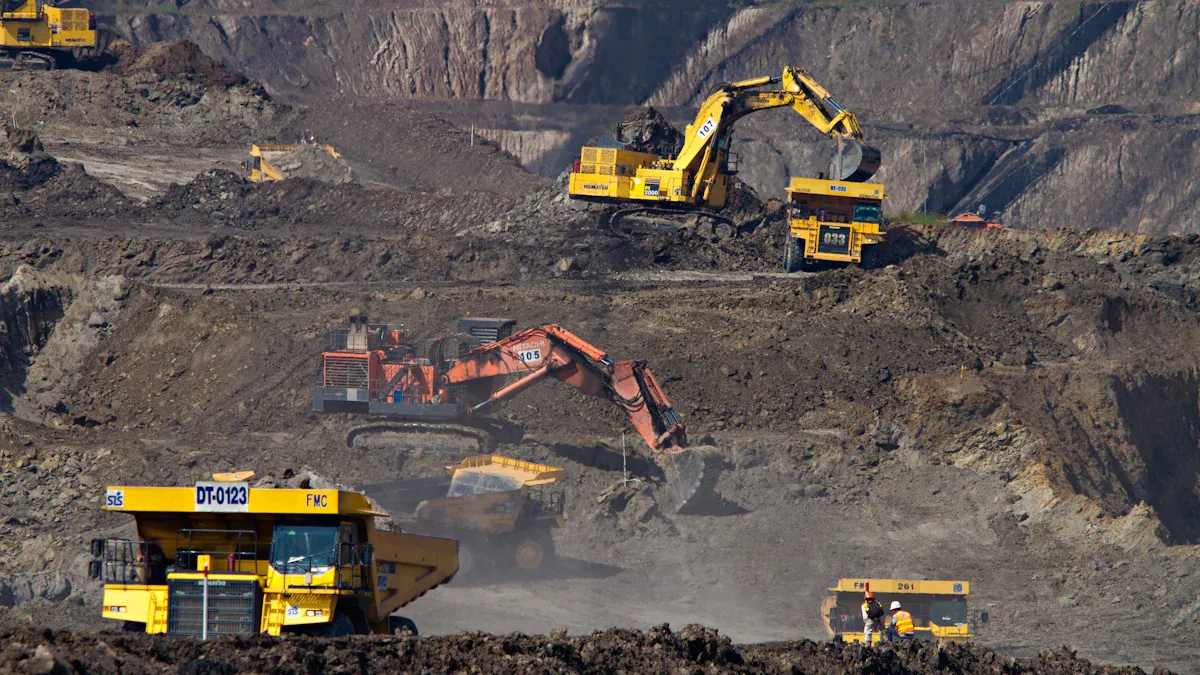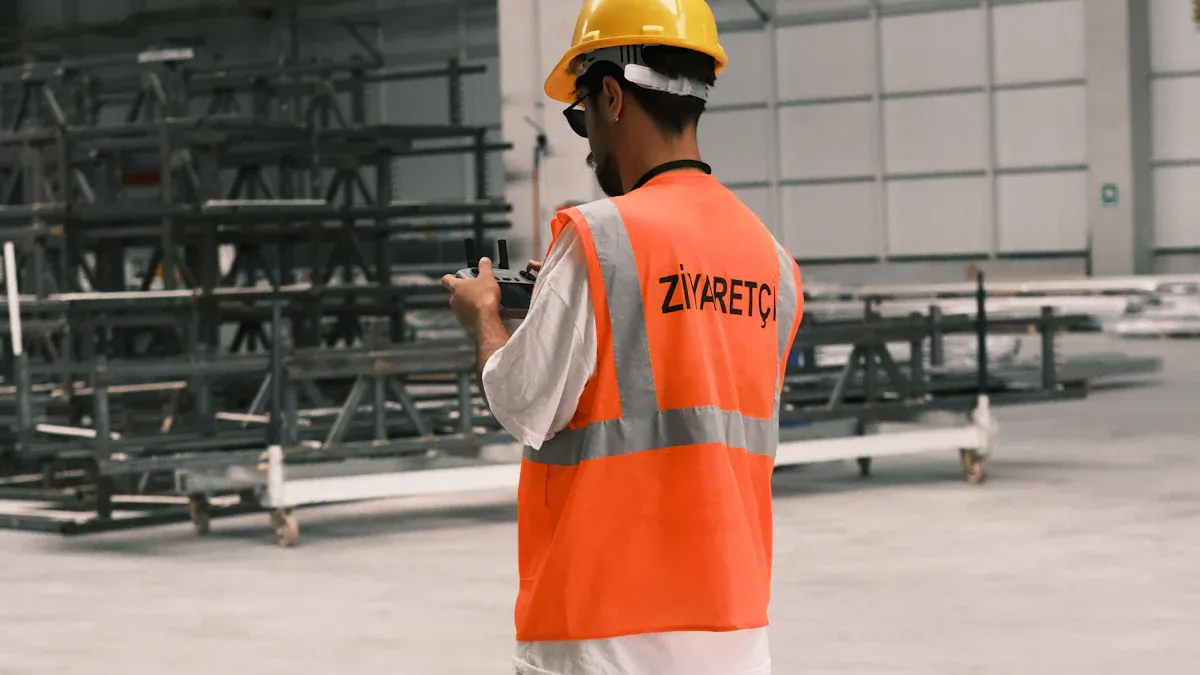
Specialized headlamps are advanced lighting devices designed for hands-free use in various challenging environments. These headlamps play a crucial role in industries like mining and construction, where visibility is essential. Improved visibility allows workers to navigate dark areas safely, significantly reducing accident risks. A study by the National Institute for Occupational Safety and Health (NIOSH) revealed that introducing intrinsically safe headlamps led to a 60% decrease in accidents related to visibility issues. This demonstrates the vital importance of specialized headlamps in enhancing worker safety across multiple applications.
Key Takeaways
- Specialized headlamps significantly enhance visibility in dark environments, reducing accident risks by up to 60%.
- Key features include high brightness levels, durable materials, and long battery life, ensuring reliability in tough conditions.
- Compliance with safety standards, such as intrinsic safety certifications, is crucial for protecting workers in hazardous environments.
- Distributors should prioritize headlamps with adjustable illumination and waterproof ratings to meet diverse operational needs.
- Understanding market dynamics and technological advancements helps distributors provide optimal headlamp solutions for their clients.
Key Features of Specialized Headlamps
Specialized headlamps offer a range of features tailored to meet the demands of industrial environments. These features enhance functionality, safety, and user experience. Below are some of the key characteristics that distinguish specialized headlamps from standard models:
- High Brightness Levels: Specialized headlamps often exceed 300 lumens, providing superior illumination compared to standard headlamps, which typically range from 25 to 500 lumens. This brightness is crucial for visibility in dark and hazardous work environments.
- Durable Materials: Manufacturers construct specialized headlamps using high-impact non-corroding ABS plastic and chemically resistant materials. These materials ensure durability in hazardous environments, making them suitable for mining and construction applications.
- Battery Life: Rechargeable LED headlamps typically last between 4 to 12 hours on a single charge. Battery life varies based on the model and brightness settings, allowing users to select headlamps that best fit their operational needs.
- Waterproof and Dustproof Ratings: Specialized headlamps come with various Ingress Protection (IP) ratings, ensuring they withstand harsh conditions. The following table outlines common waterproof and dustproof ratings found in industrial headlamps:
| IPX Rating | Description | Suitable Use |
|---|---|---|
| IPX4 | Resists splashes from all directions. | Light rain or sweat. |
| IPX6 | Protects against powerful water jets. | Heavy rain. |
| IPX7 | Waterproof up to 1 meter for 30 minutes. | Accidental submersion risks. |
| IPX8 | Submersible beyond 1 meter. | Prolonged water exposure. |
- Innovative Technology: Recent advancements in headlamp technology include features such as Bluetooth connectivity, which allows users to adjust settings and check battery status via smartphone. This innovation enhances user interaction and convenience.
- Energy Efficiency: Energy-efficient models, such as rechargeable and LED headlamps, lead to significant long-term savings. They eliminate the need for disposable batteries, reducing waste and ongoing expenses. Additionally, LED headlamps consume less energy than traditional options, resulting in lower electricity bills.
Applications in Mining

Mining operations require reliable lighting solutions to ensure safety and efficiency. Specialized headlamps play a vital role in these environments, offering features tailored to the unique challenges faced by miners.
Mining Headlamp Features
Mining headlamps provide several advantages over standard lighting solutions. They deliver focused, hands-free illumination, which is essential in dark and confined spaces. The following features enhance their effectiveness:
- Focused Beam: Specialized headlamps emit a concentrated beam of light, allowing miners to see clearly in narrow tunnels and shafts.
- Reduced Shadows and Glare: These headlamps minimize shadows and glare, improving visibility and safety. This clarity helps workers perform tasks more accurately and efficiently.
- Enhanced Productivity: Proper lighting is linked to increased productivity. Miners can assess geological formations better, leading to precise extraction and reduced waste.
- Durability: Mining headlamps are built to withstand harsh conditions. They often feature rugged designs that resist impacts and environmental wear.
Safety Standards for Mining Headlamps
Safety is paramount in mining operations. Specialized headlamps must comply with strict safety standards to protect workers. Key safety regulations include:
- Intrinsic Safety: Many mining headlamps are designed to be intrinsically safe. This means they prevent sparks that could ignite flammable gases or dust.
- Certification: Headlamps should meet industry certifications such as ATEX or IECEx, which ensure they are safe for use in explosive atmospheres.
- Battery Safety: Rechargeable batteries must undergo rigorous testing to prevent overheating or failure during operation.
By adhering to these safety standards, specialized headlamps significantly enhance the safety of mining operations, allowing workers to focus on their tasks without the constant worry of inadequate lighting.
Applications in Construction

Construction sites present unique challenges that necessitate reliable lighting solutions. Specialized headlamps are essential tools for ensuring worker safety and efficiency in these environments.
Construction Site Requirements
Effective lighting is crucial on construction sites. Workers face various hazards, and proper illumination minimizes risks. According to Scott Colarusso, General Manager and Co-Owner of All Hands Fire Equipment & Training, “It is safer to provide suitable headlamps upfront rather than leaving it up to employees to make their own purchases.” This proactive approach helps prevent serious injuries.
Key requirements for headlamps on construction sites include:
- Compliance with OSHA Standards: Headlamps must meet OSHA’s definition of personal protective equipment (PPE). This compliance is vital for minimizing exposure to hazards that can cause serious injuries.
- Durability: Headlamps must withstand harsh conditions, including accidental drops and collisions.
- Waterproofing: Essential for working in wet conditions, ensuring functionality in rain.
- Adjustable Illumination: Different tasks require varying light intensities and modes, such as spot and diffuse lighting.
Failure to provide suitable headlamps can lead to serious accidents on construction sites. High-quality headlamps protect workers from potentially lethal accidents. Companies risk liability if they do not provide safety-certified headlamps appropriate for hazardous environments.
Recommended Headlamp Types for Construction
When selecting headlamps for construction, durability and performance are paramount. The following table outlines some recommended models based on these criteria:
| Headlamp Model | Lumens | Distance (ft) | Durability Features | Special Features |
|---|---|---|---|---|
| Fenix HM71R | 2700 | 755 | High-strength A6061-T6 aluminum, withstands drops and jolts | Magnetic base, hands-free option |
| Fenix HP30R V2.0 | 3000 | 886 | Separate battery case, powered by two 21700 Li-ion batteries | Instant-on switch, comfortable wear |
| Fenix WH23R | 600 | 328 | IP66 rated dustproof, heavy splash proof, oil resistant, impact resistant to 2m | Smart motion sensor |
| Fenix HM61R V2.0 | 1600 | N/A | Durable design for industrial lighting scenarios | Glove-friendly switch, multiple brightness levels |
These specialized headlamps enhance visibility and safety, making them ideal for construction environments.
Safety Applications
Specialized headlamps play a critical role in safety applications, particularly in environments where visibility is limited and hazards are present. These headlamps are designed with several safety features that enhance their effectiveness in emergency response and other safety-critical situations.
Safety Features of Specialized Headlamps
The following safety features are commonly integrated into specialized headlamps for emergency response teams:
- Intrinsic Safety: This feature prevents ignition in hazardous environments, making these headlamps suitable for use in explosive atmospheres.
- Adjustable Brightness Modes: Users can customize light output for specific tasks, ensuring optimal visibility based on the situation.
- Compliance with Industry Safety Standards: Specialized headlamps meet rigorous safety standards, ensuring safe operation in volatile conditions.
These features significantly reduce the risk of accidents in hazardous safety applications. For instance, specialized headlamps prevent ignitions in explosive atmospheres, which is crucial for safety. They provide reliable illumination in low-light conditions, enhancing visibility and reducing accident risks. Compliance with safety regulations is ensured through the use of intrinsically safe headlamps, designed to avoid sparking in environments with flammable materials.
Compliance with Safety Regulations
Compliance with safety regulations is essential for the effective use of specialized headlamps in safety-critical industries. The following table outlines key regulations governing headlamp use:
| Regulation | Description |
|---|---|
| OSHA Standard (Subpart AA of 29 CFR 1926) | Requires employers to assess hazards in confined spaces and ensure proper safety measures, including the use of certified headlamps. |
| Intrinsically Safe Certification | Ensures headlamps are safe for use in hazardous environments by preventing ignition sources. |
| IEC and CENELEC Standards | Define specific safety standards for intrinsically safe equipment, ensuring compliance in industries like mining and oil and gas. |
John Navarro emphasizes the importance of intrinsically safe headlamps to prevent potential liability and ensure worker safety in hazardous environments. He notes that these headlamps meet safety standards, allowing employees to work safely under various conditions. Manufacturers ensure compliance with safety regulations through rigorous testing and adherence to established standards, ultimately safeguarding workers in critical situations.
Choosing the Right Headlamp
Selecting the right headlamp for industrial applications involves careful consideration of various factors. Distributors must understand the specific needs of their clients in mining, construction, and safety environments. Here are some essential factors to consider:
Factors to Consider
- Illumination Strength and Versatility: Different jobs require varying light modes. For instance, high beams are ideal for long-distance visibility, while softer beams work better for close-up tasks. This versatility ensures that workers can adapt to different conditions effectively.
- Battery Life: Long battery run time is crucial to avoid work stoppages. In hazardous environments, reliable battery performance enhances safety and productivity. Distributors should prioritize headlamps that offer extended runtimes to meet the demands of their clients.
- Safety Ratings: Headlamps must conform to safety standards. Compliance with regulations prevents endangering workers and equipment. Distributors should verify that the headlamps they offer meet industry-specific safety certifications.
User requirements in mining, construction, and safety applications dictate the selection of headlamps. Essential features such as safety, durability, illumination strength, and battery life are crucial for ensuring reliable performance in hazardous environments. These attributes ultimately enhance worker safety.
Comparing Different Headlamp Models
When evaluating different headlamp models, several technical specifications come into play. Distributors should compare the following aspects:
- Weight: Lighter headlamps reduce fatigue during extended use.
- Comfort: Adjustable straps and ergonomic designs enhance user comfort.
- Ease of Use: Intuitive controls allow for quick adjustments in the field.
- Burn Time: Longer burn times minimize the need for frequent recharging.
- Illumination and Light Quality: High-quality light output improves visibility.
- Features: Additional functionalities, such as multiple light modes, can enhance usability.
- Value: Cost-effectiveness is essential for budget-conscious clients.
- Durability: Robust construction ensures longevity in tough environments.
- Weather Resistance: Headlamps should withstand various weather conditions.
- Battery Type: Rechargeable options are often more economical in the long run.
- Light Modes: Different modes cater to specific tasks and environments.
Distributors can utilize a comparison table to summarize the key specifications of various headlamp models. This visual aid helps clients make informed decisions based on their specific needs.
| Headlamp Model | Weight | Burn Time | Durability | Light Modes | Price Range |
|---|---|---|---|---|---|
| Model A | 200g | 10 hours | IP67 | 3 modes | $50-$70 |
| Model B | 250g | 12 hours | IP68 | 5 modes | $80-$100 |
| Model C | 180g | 8 hours | IP66 | 2 modes | $40-$60 |
By considering these factors and comparing different models, distributors can ensure they provide specialized headlamps that meet the rigorous demands of their clients in mining, construction, and safety applications.
Specialized headlamps are essential tools in mining, construction, and safety applications. They enhance visibility, improve worker safety, and boost productivity. Distributors must recognize the challenges they face when sourcing these products. Key challenges include:
- Brand Recognition: Established brands dominate consumer trust.
- Pricing Pressure: Intense competition can lead to price wars.
- Market Research: Understanding local dynamics is crucial.
Distributors should also consider technological advancements in headlamp design. Innovations like adaptive driving beam systems and matrix LED configurations improve visibility and safety. By partnering with manufacturers, distributors can access customization services and dedicated customer support, ensuring they meet market demands effectively.
In summary, selecting the right specialized headlamp involves understanding both the product features and the market landscape. This knowledge empowers distributors to provide optimal solutions for their clients.
FAQ
What are specialized headlamps?
Specialized headlamps are advanced lighting devices designed for hands-free use in challenging environments. They provide essential illumination for industries like mining, construction, and safety applications.
How do I choose the right headlamp for my needs?
Consider factors such as brightness, battery life, durability, and safety ratings. Assess the specific requirements of your work environment to select the most suitable headlamp.
Are specialized headlamps waterproof?
Many specialized headlamps feature waterproof ratings, such as IPX4 to IPX8. These ratings indicate their ability to withstand various water exposure levels, making them suitable for wet conditions.
How long do the batteries last in specialized headlamps?
Battery life varies by model and usage. Most rechargeable headlamps offer runtimes between 4 to 12 hours, depending on brightness settings and usage patterns.
Do specialized headlamps comply with safety regulations?
Yes, specialized headlamps must meet industry safety standards, such as OSHA and intrinsic safety certifications. Compliance ensures safe operation in hazardous environments, protecting workers effectively.
Post time: Sep-25-2025
 fannie@nbtorch.com
fannie@nbtorch.com +0086-0574-28909873
+0086-0574-28909873





